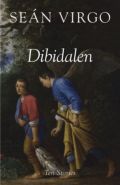Reviews
Fiction Review by Paul Franz
Seán Virgo, Dibidalen: Ten Stories (Saskatoon: Thistledown, 2012). Paperbound, 193 pp., $18.95.

The poet and fiction writer Seán Virgo, an adoptive Canadian born to Anglo-Irish parents in Malta, has for years laboured over a body of work devoted to seemingly contrary ends. Resisting identification with any particular literary or cultural tradition (the exception, a 1983 collection Through the Eyes of a Cat: Irish Stories, proves the rule when its preface vows he will “write no more Irish stories”), Virgo nonetheless staunchly defends the local and tactile. The current volume, named for a valley in Norway, marks an impressive addition to this oeuvre. Mixing prose with terse recitative, Dibidalen aspires to a condition rare in today’s fiction—stony, bardic, yet also tenderly disconsolate.
The book divides readily into two major sections, the first of which, despite taking up a quarter of its length, contains seven of its ten stories. This difference in scale implies corresponding contrasts in technique and theme. In their extreme brevity, the stories of the first section (the shortest is less than four pages, in contrast to the volume’s longest, with fifty-nine) suggest an impulse toward radical paring-down: of plot, of character, of all merely external detail. With their unfamiliar, windswept settings, several could almost be mistaken for fantasy or science fiction, if Virgo did not avoid those genres’ distinctive luxuriance in the details of their imagined worlds. Landscape in these tales instead provides an empty stage for elemental dramas of youth attaining to knowledge, or age accepting irrevocable loss. When a farmer, in cosmic punishment for a trivial transgression, finds himself dispossessed of child, wife, and home, with no choice but to depart along the way “that leads by every man’s house,” we understand what we are being asked to imagine: a stripping away to a universal substratum.
The relative expansiveness of the three remaining stories reflects the way they make room for what the earlier stories exclude. “The Likeness,” for instance, acknowledges its settings in Toronto and Paris, while the title story partly takes place in Norway during the Second World War. More important is the new prevalence of dialogue. The first section focuses on characters isolated by language or generational gaps—sometimes making them seem like housemates who never see each other, because they work different shifts. When connection does take place, it requires an often wary surrender to something left unspoken. The second section, however, introduces relationships from the daylight, modern world. The first of these longer stories, “Gramarye,” feels out of place, its stilted speech unable to prevent its tale—of a young girl’s coming-of-age under the tutelage of a woman reputed to be a witch—from descending into triteness. “The Likeness” and the title story, “Dibidalen,” however, approach that root meaning of “stilted”—walking on stilts—which Yeats made a metaphor for “high talk.” For these stories do not truly abandon the ancient world of fable so much as they explore its uncertain survival into the present. The caged lynx of “The Likeness,” a Canadian updating of Rilke’s panther, is one representation of this tension; the same story’s depiction of an artist haunted by new embodiments of past lovers is another. Most intriguing is the title story, which imagines a secret language, called mussprak, or “mouse-speech,” spoken only by the women of an isolated Scandinavian valley, some few of whom in every generation are fated to remain small into adulthood, bearing curious mouse-like features. This sense of a fate that at once isolates those whom it singles out and joins them in a special community links this final story to the collection’s prevailing theme of rites of initiation.
Stylistically, the volume bears evidence throughout of an essentially poetic attention to the linguistic medium. This is true both of those stories laid out in verse and those in prose, which likewise make important use of repetition and incantatory rhythms. Avoiding, for the most part, any attempt at grounding its third-person vantage point within the world being depicted, the language instead seems to aim at a kind of authorlessness, welling up out of no-place, implacable as the landscape itself. Such monumental ease requires special vigilance, as it renders all the more distracting any word or phrase that calls too much attention to the hand of the maker. The best writing in the collection, that most severely cut to the bone, and hence senseless to excerpt, provides the internal standard for judging such missteps as “The firepit glowed and winked, and a chill of unease eddied through his breast.” The book’s emphasis on fate and cycles is another double edged sword; a source of the sublime, it shades into complacency when certain stories, like “The Shark Mother,” too readily crest the narrative hill before sinking down to their own foregone conclusions. What Virgo is doing here, in other words, requires a special balancing act, one almost impossible to achieve consistently. Yet the narrative pattern of the first story, in which an older teacher, walking through the wilderness, time and again outstrips his charge, forcing the boy to undergo various hardships to keep up, provides a suitable emblem for its successes. When the writer leads the way into the realm of challenge and risk, the reader will follow.
—Paul Franz









